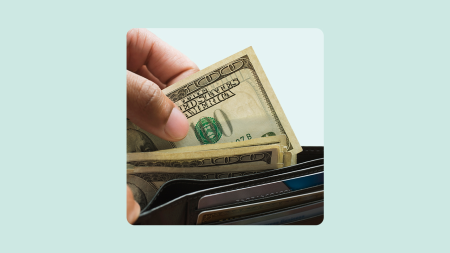Key takeaways
- A goodwill letter is a formal request to a creditor asking them to remove a negative mark, like a late payment, from your credit report.
- Goodwill letters are most effective when the late payment was an isolated incident caused by unforeseen circumstances, such as a financial hardship or medical emergency.
- Lenders do not have to respond to a goodwill letter, and many large lenders and credit card issuers have policies against it.
If you’ve ever missed a payment on your credit card or loan, you know the sinking feeling that follows. It’s an easy mistake but can have serious consequences, including late fees and higher interest rates. Payments made more than 30 days late can also drop your credit score.
If you’ve missed only one or two payments, you might consider writing a goodwill letter.
While it won’t get you a refund on late fees or better terms from your lender, a well-crafted letter might convince your creditor to remove that negative mark, helping to clean up your credit history and improve your score.
What is a goodwill letter?
A goodwill letter is a formal letter sent to a creditor, lender or collection agency to request forgiveness for a late payment or other negative item on your credit report.
In the letter, you typically:
- Explain the circumstances that led to the late payment or issue.
- Express remorse and your intention to pay on time going forward. It may be helpful to add how you plan to prevent the issue, such as by using automatic payments.
- Request that the creditor consider removing or adjusting the negative item.
After reviewing your request, the lender may decide to make the requested changes to your account as a gesture of goodwill. However, if you’re going to send a goodwill letter, keep your expectations low because a letter often won’t make a difference.
Lenders are not obligated to honor your request or even respond to your letter. In fact, many larger lenders and credit card issuers state that they do not accept goodwill letters, as they are legally and contractually obligated to provide accurate reporting of account activity, including late payments. Still, some people report success trying this method.
Researching the creditor’s policies regarding late payments and goodwill adjustments may provide insight into the likelihood of success. If there is no clearly stated policy denying goodwill letters, sending one out may be worth the effort.
While there are no guarantees, a well-written goodwill letter may persuade a creditor to ask the credit bureau to remove the negative mark from your credit report. If the bureau agrees, the update could help prevent future credit difficulties.
Bankrate insight
A goodwill letter is not a credit dispute. A goodwill letter is to creditors to ask for leniency on a derogatory mark that is accurate. A dispute is asking a credit bureau to verify the accuracy of something on your credit report.
When should you write a goodwill letter?
Consider writing a goodwill letter when you’ve had a late payment or other negative item reported on your credit report due to circumstances beyond your control. Suitable situations might include a temporary financial hardship, medical emergency or personal crisis.
If you’re going to try asking for forgiveness, ensure that the late payment or issue was a one-time occurrence and not a recurring problem. Also, only proceed with a goodwill letter if you plan to maintain good financial habits going forward.
You may have a better chance of success when you can explain why your situation deserves understanding.
Many lenders offer financial hardship programs that can help through difficult times. Most lenders prefer that you leverage these programs as soon as you start having financial difficulties, rather than missing payments and asking for forgiveness later.
Ultimately, if the lender sees that the late payment is part of a pattern of irresponsible financial behavior rather than an isolated incident, they’ll likely deny your request.
Note that late payments aren’t reported to credit bureaus until they are 30 days or more late. You don’t need to write a letter if you miss a payment and correct your error quickly. You can simply pay any applicable late fees and make sure to pay on time in the future.
How do you write an effective goodwill letter?
A goodwill letter should be written formally, showing your lender that you take your late payment seriously. It shows respect for the process and a willingness to act professionally, which can work in your favor. You’ll also want to personalize your message, making sure to be both sincere and polite.
When crafting your letter, consider the following points:
- Address the creditor or lender respectfully and thank them for their time.
- Clearly explain the situation that led to the late payment with relevant details and/or documentation to support your explanation.
- Own up to the mistake without excuses. Acknowledge any errors and express genuine remorse for any inconvenience caused.
- If applicable, emphasize your good payment history with the creditor. Mention previous instances of on-time payments or your long-standing relationship with them.
- Reassure the creditor that the late payment was a one-time occurrence and not typical of your financial behavior. Explain any steps you’ve taken to prevent future issues.
- Clearly state what you’re asking for, whether it’s the removal of the negative item from your credit report, a late fee waiver or another form of leniency.
- Thank them for their time and express hope for a positive resolution.
Before sending your letter, carefully review it for clarity, accuracy and professionalism. Make any necessary revisions to ensure your message is clear and persuasive.
What to include in a goodwill letter
Here is an example template for a possible letter.
Header
[Your Name][Your Address][City, State, Zip][Phone Number][Email Address]
[Date]
Recipient’s information
[Creditor/Lender’s Name][Creditor/Lender’s Address]
Dear [Creditor/Lender’s Name],
I am writing to address a recent late payment on my account with [Creditor/Lender’s Name].
[Explain the circumstances that led to the late payment or negative item on your credit report. Be honest and provide relevant details. Note any documentation you can enclose.]
I take full responsibility for the late payment. [Acknowledge any mistakes made and express genuine remorse for any inconvenience caused.]
Despite this incident, I have maintained a positive payment history with [Creditor/Lender’s Name]. [Highlight any previous instances of on-time payments or your long-standing relationship with the creditor.]
I assure you that this late payment was an isolated incident. [Reassure the creditor that the late payment was not typical of your financial behavior and explain any steps taken to prevent future issues.]
I kindly request [specific action, such as the removal of the negative item from your credit report, a waiver of late fees or another form of leniency].
Thank you for taking the time to consider my request. I appreciate your understanding and cooperation in this matter.
Sincerely,
[Your signature]
Also, list any additional documents included with the goodwill letter, such as proof of payment or hardship letters.
How do you send a goodwill letter?
If you plan to send your letter by postal mail, start by checking the recipient’s website to confirm the proper mailing address. Consider sending the letter via certified mail to confirm delivery. You will pay a little extra for this option, but it can be worthwhile to keep detailed records.
Remember that lenders are not obligated to respond to your letter at all.
What if your goodwill letter is declined?
Throughout this process, it’s important to manage your expectations. A goodwill letter is a request for leniency, not a guaranteed solution. If the creditor doesn’t respond or denies your request, consider debt management alternatives, such as:
Depending on your circumstances, these options may help you get your credit back on track, despite the late payment.
What do you do if you never made a late payment?
If you notice a late payment on your credit report and believe you have made all your payments on time, you’ll want to take a different course of action. In this case, you can contact the creditor to address the inaccuracy or dispute the misreported payment directly with the three credit bureaus: TransUnion, Experian and Equifax.
Next steps
It’s always best to avoid late payments, but inadvertently missing a payment doesn’t have to be the end of the world for your credit score. Sometimes, a well-written goodwill letter can persuade creditors to remove a negative incident from your credit report. To improve your chances of success, make sure it is an isolated incident, express your sincere regret, and provide documentation to support your case.
Remember that creditors may not approve or even respond to your request. If your goodwill letter does not result in the removal of your late payment, you may consider other options, such as credit counseling, debt settlement or credit repair services. Over time, these solutions could help improve your credit score.
Frequently asked questions
Read the full article here










